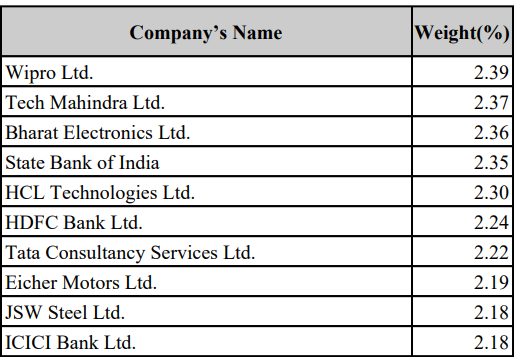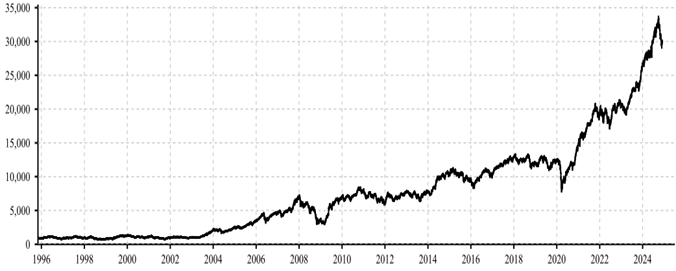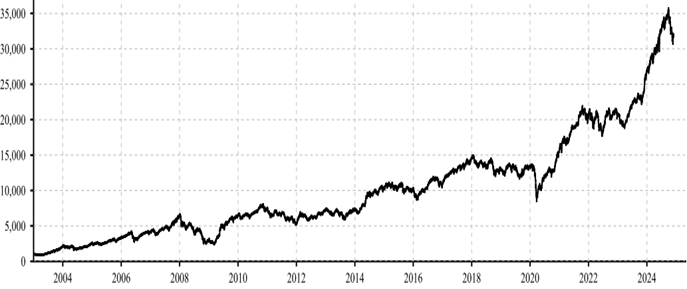Kotak Mutual Fund Offering Two Equal Weight Index Funds: Should You Invest?
Dec 13, 2024
Kotak Mutual Fund has launched a series of Index Funds this calendar year. This is perhaps recognising the interest of investors in passively managed funds and the fact quite a sizeable number of actively managed equity funds have failed to beat their benchmark, i.e. generate alpha.
It appears that the fund house is consciously building its product portfolio with passively managed funds. Currently, the fund house has launched two Index Funds:
|
Scheme Name |
Issue Open and Close Date |
Re-opens for continuous Sale & Repurchase |
|
Kotak Nifty 50 Equal Weight Index Fund |
2-Dec-2024 - 16-Dec-2024 |
30-Dec-2024 |
|
Kotak Nifty 100 Equal Weight Index Fund |
2-Dec-2024 - 16-Dec-2024 |
30-Dec-2024 |
Let's understand each of these Schemes in detail.
Kotak Nifty 50 Equal Weight Index Fund
This is an open-ended scheme replicating/tracking the Nifty 50 Equal Weight Index. In other words, the returns would commensurate with the performance of the Nifty 50 Equal Weight Index over the long term, subject to tracking error.
The Scheme will invest 95% to 100% of its total assets in equity & equity-related securities covered by the Nifty 50 Equal Weight Index.
The Scheme may take exposure to equity derivatives of constituents or index derivatives of the underlying index for a short duration when securities of the index are unavailable, insufficient or for rebalancing at the time of change in the index or in case of corporate actions, as permitted subject to rebalancing within 7 calendar days (or as specified by SEBI from time to time). The equity derivative exposure of the scheme for non-hedging purposes shall be up to 20% of equity and equity-related securities of the Scheme.
Up to 5% of the total assets of the Scheme will be invested in Debt/ Money Market instruments.
Money Market instruments include commercial papers, commercial bills, treasury bills, Government securities having an unexpired maturity of up to one year, call or notice money, certificate of deposit, usance bills, triparty repo and any other like instruments as specified by the Reserve Bank of India (RBI) from time to time and subject to regulatory approval.
The Scheme may also invest up to 5% of net assets in Liquid Funds and Overnight Mutual Fund schemes without charging any fees.
Further, the Scheme may indulge in Securities Lending not exceeding 20% of its net assets and exposure to a single entity not exceeding 5% of the net assets of the Scheme.
The Scheme shall not invest in the following:
- Credit Default Swaps
- ADR/GDR/overseas securities/ foreign securities
- Debt instruments with special features
- Securitized debt
- Commodity derivatives and debt derivative instruments
- Structured Obligations (SOs) and Credit Enhancements (CEs)
- Repo/ reverse repo transactions in corporate debt securities
- Units of Real Estate Investment Trusts (REITs), Infrastructure Investment Trusts (InvITs)
Also, the Scheme shall not engage in short selling of securities.
What Is the Investment Objective?
The investment objective of Kotak Nifty 50 Equal Weight Index Fund is to provide returns that, before expenses, corresponding to the total returns of the securities as represented by the underlying index, subject to tracking errors.
There is no assurance that the investment objective of the Scheme will be achieved.
What is the Investment Strategy?
To achieve the investment objective, the scheme will follow a passive investment strategy with investments in stocks in the same proportion as in the Nifty 50 Equal Weight Index. The investment strategy would revolve around reducing the tracking error through rebalancing of the portfolio, taking into account the change in weights of stocks in the index as well as the incremental collections/redemptions from the Scheme.
Index Scheme being a passive investment carries lesser risk as compared to active fund management. The portfolio follows the index and therefore the level of stock concentration in the portfolio and its volatility would be the same as that of the index, subject to tracking error. Thus, there is no additional element of volatility or stock concentration on account of fund manager decisions.
A small portion of the net assets will be held as cash or will be invested in debt and money market instruments permitted by SEBI/RBI including TREPS or in alternative investment for the TREPS as may be provided by the RBI, to meet the liquidity requirements under the Scheme.
The Scheme may invest in the units of mutual fund schemes of Kotak Mahindra Mutual Fund or any other Mutual Funds in terms of the prevailing SEBI (MF) Regulations.
The Scheme may also take exposure to equity derivatives of constituents or index derivatives of the underlying 14 index for a short duration when securities of the index are unavailable, insufficient or for rebalancing at the time of change in the index or in case of corporate actions, as permitted by SEBI from time to time.
The Scheme may use SLBM for earning additional income for the scheme with a lesser degree of risk.
The Scheme endeavours to achieve a return equivalent to the underlying index while minimizing tracking error.
The underlying index of the Scheme, i.e. the benchmark is the Nifty 50 Equal Weight Index - Total Return Index (TRI).
About the Nifty 50 Equal Weight Index
The Nifty 50 Equal Weight Index (launched on April 13, 2017, with a base date of November 3, 1995) represents an alternative weighting strategy to its market capitalisation-based parent index, the Nifty 50 Index. The index includes the same companies as its parent index, however, weighted equally.
The Nifty 50 Equal Weight Index is rebalanced quarterly where weights are rebalanced back to equal. The index is reconstituted semi-annually along with the Nifty 50 Index.
Currently, the top 10 constituents of this index are as under:
Table 1: Top 10 constituents of the Nifty 50 Equal Weight Index
 (Source: NSE Indexogram Factsheet as of November 29, 2024)
(Source: NSE Indexogram Factsheet as of November 29, 2024)
The Nifty 50 Equal Weight Index has exposure to a diverse range of sectors - from financial services to consumer services.
Since the base date of November 3, 1995, the Nifty 50 Equal Weight Index has clocked a price return of 12.4% CAGR and a total return (which includes dividends) of 14.5% (as of November 29, 2024).
In the last 5 years, the Nifty 50 Equal Weight Index created wealth for an appealing pace with a price return of 19.2% CAGR and a total return of 20.9% CAGR (as of November 29, 2024).
Graph 1: Long-term Performance of the Nifty 50 Equal Weight Index
 (Source: NSE Indexogram Factsheet as of November 29, 2024)
(Source: NSE Indexogram Factsheet as of November 29, 2024)
Since the lows of the COVID-19 pandemic, the Nifty 50 Equal Weight Index has nearly tripled investors' wealth.
Who Should Consider Kotak Nifty 50 Equal Weight Index Fund?
Investors looking to gain exposure to frontline Nifty 50 stocks in equal weight keeping the cost of investing relatively low (compared to actively managed funds), could consider the Kotak Nifty 50 Equal Weight Index Fund provided you have the stomach for very high-risk and a time horizon of at least 3 to 5 years. That being said, the fortune of the Scheme will be closely linked to the performance of the underlying index, subject to the tracking error.
To learn more about the Kotak Nifty 50 Equal Weight Index Fund, read the Scheme Information Document (SID) and Key Information Memorandum (KIM).
Kotak Nifty 100 Equal Weight Index Fund
This is an open-ended scheme replicating/tracking the Nifty 100 Equal Weight Index. Thus, the returns would commensurate with the performance of the Nifty Midcap, subject to tracking error.
The Scheme will invest 95% to 100% of its total assets in equity & equity-related securities covered by the Nifty 100 Equal Weight Index.
The Scheme may take exposure to equity derivatives of constituents or index derivatives of the underlying index for a short duration when securities of the index are unavailable, insufficient or for rebalancing at the time of change in the index or in case of corporate actions, as permitted subject to rebalancing within 7 calendar days (or as specified by SEBI from time to time). The equity derivative exposure of the Scheme for non-hedging purposes shall be up to 20% of equity and equity-related securities of the Scheme.
Up to 5% of the total assets of the Scheme will be invested in Debt/ Money Market instruments.
Money Market instruments include commercial papers, commercial bills, treasury bills, Government securities having an unexpired maturity of up to one year, call or notice money, certificate of deposit, usance bills, triparty repo and any other like instruments as specified by the Reserve Bank of India (RBI) from time to time and subject to regulatory approval.
The Scheme may also invest up to 5% of net assets in Liquid & Overnight Mutual Fund schemes without charging any fees.
Further, the Scheme may indulge in Securities Lending not exceeding 20% of its net assets and exposure to a single entity not exceeding 5% of the net assets of the scheme.
The Scheme does not intend to undertake/ invest/ engage in:
- ADR/GDR/overseas securities/ foreign securities
- Credit Default Swaps
- Units of Real Estate Investment Trusts (REITs) and Infrastructure Investment Trusts (InvITs)
- Debt instruments with special features
- Securitized debt
- Investment in commodity derivatives and debt derivative instruments
- Structured Obligations (SOs) and Credit Enhancements
- Repo/ reverse repo transactions in corporate debt securities
- Short Selling of Securities
What Is the Investment Objective?
The investment objective of the Kotak Nifty 100 Equal Weight Index Fund is to provide returns that, before expenses, corresponding to the total returns of the securities as represented by the underlying index, subject to tracking errors. However, there is no guarantee or assurance that the investment objective of the Scheme will be achieved.
What is the Investment Strategy?
To achieve the investment objective, the scheme will follow a passive investment strategy with investments in stocks in the same proportion as in the Nifty 100 Equal Weight Index. The investment strategy would revolve around reducing the tracking error through rebalancing of the portfolio, taking into account the change in weights of stocks in the index as well as the incremental collections/redemptions from the Scheme.
A small portion of the net assets (of up to 5%) will be held as cash or will be invested in debt and money market instruments as permitted by SEBI/RBI including TREPS or in alternative investment for the TREPS as may be provided by the RBI, to meet the liquidity requirements under the Scheme.
Scheme may invest in the units of Mutual Fund schemes of Kotak Mahindra Mutual Fund or any other Mutual Funds in terms of the prevailing SEBI (MF) Regulations.
Further, the Scheme may take exposure to equity derivatives of constituents or index derivatives of the underlying index for a short duration when securities of the index are unavailable, insufficient or for rebalancing at the time of change in the index or in case of corporate actions, as permitted by SEBI from time to time.
The Scheme may use SLBM for earning additional income for the scheme with a lesser degree of risk.
The Scheme endeavours to achieve a return equivalent to the underlying index while minimizing tracking error.
The underlying index of the Scheme, i.e. the benchmark is the Nifty 100 Equal Weight Index - Total Return Index (TRI).
About the Nifty 100 Equal Weight Index
The Nifty 100 Equal Weight Index (launched on June 10, 2013, with the base date as January 1, 2003) comprises of same constituents as the Nifty 100 Index (free float market capitalisation-based Index). The Nifty 100 Index tracks the behaviour of a combined portfolio of two indices viz. Nifty 50 and Nifty Next 50.
Each constituent in the Nifty 100 Equal Weight Index is allocated a fixed equal weight at each rebalancing. The Nifty 100 Equal Weight Index is reconstituted semi-annually along with the Nifty 100 Index. The rebalancing happens quarterly where weights are rebalanced back to equal.
Currently, the top 10 constituents of this index are as under:
Table 2: Top 10 constituents of the Nifty 100 Equal Weight Index
 (Source: NSE Indexogram Factsheet as of November 29, 2024)
(Source: NSE Indexogram Factsheet as of November 29, 2024)
The Nifty 100 Equal Weight Index has exposure to a diverse range of sectors - from Financial Services to Telecommunication.
Since the base date of January 1, 2003, the Nifty 100 Equal Weight Index has clocked a price return of 17.1% CAGR and a total return (which includes dividends) of 19.0% (as of November 29, 2024).
Graph 2: Long-term Performance of the Nifty 100 Equal Weight Index
 (Source: NSE Indexogram Factsheet as of November 29, 2024)
(Source: NSE Indexogram Factsheet as of November 29, 2024)
In the last 5 years, the Nifty 100 Equal Weight Index has clocked a CAGR of 19.2% on price returns and a total return of 20.3% CAGR (as of November 29, 2024).
Who Should Consider Kotak Nifty 100 Equal Weight Index Fund?
Investors look to gain exposure to a combined portfolio of two indices viz. Nifty 50 and Nifty Next 50, in equal weightage and keeping the cost of investing relatively low, could consider the Kotak Nifty 100 Equal Weight Index Fund provided you have a very high risk and a time horizon of at least 3 to 5 years.
Keep in mind, that the fortune of the Scheme will be closely linked to the performance of the underlying index, subject to tracking error.
To learn more about the Kotak Nifty 100 Equal Weight Index Fund, read the Scheme Information Document (SID) and Key Information Memorandum (KIM).
Who Will Manage These Schemes?
Mr. Devender Singhal and Mr. Satish Dondapati will be the designated Fund Managers for the Scheme.
Mr. Abhishek Bisen will be the Fund Manager for the debt securities of the Scheme.
Mr Singhal has more than 22 years of experience in fund management and equity research of which the last 15 years have been with Kotak AMC. Before that, he was part of various PMS like Kotak, Religare, Karvy and P N Vijay Financial Services.
He holds an honours degree in mathematics from Delhi University and PGDM (Finance, Insurance).
Currently, he is managing assets across multicap and hybrid strategies, plus various other index funds and equity-oriented Exchange Traded Funds (ETFs) at the fund house.
Mr Dondapati has over 16 years of experience in ETFs. He has been there with Kotak AMC since March 2008, and before that was in the mutual fund product team of Centurion Bank of Punjab. He holds an MBA (Finance). He co-manages various passive funds at the fund house.
Mr Bisen has been associated with Kotak AMC since October 2006 and his key responsibilities include fund management of debt schemes. Mr Kotak AMC, Mr Bisen has worked with Securities Trading Corporation of India Ltd where he was looking at Sales & Trading of Fixed Income Products apart from doing Portfolio Advisory. His earlier assignments also include two years of merchant banking experience with a leading merchant banking firm. He holds a bachelor's degree in arts (BA - Management) and an MBA (Finance).
Minimum Investment, Plans and Options Available
The minimum investment in both these Schemes during the NFO period and on a continuous basis is Rs 100/- and any amount thereafter.
Switch-in and Systematic Investment Plans (SIPs) are available during the NFO period for investment.
The Schemes offer both a Regular Plan and a Direct Plan to invest.
Each plan offers the Growth Option and the Income Distribution cum Capital Withdrawal Option (IDCW) for investing.
[Read: IDCW vs Growth Option: Which One Should You Opt for]
To Conclude...
Kotak Mutual Fund is a fund house following strong investment processes and systems. Index funds, in general, are less risky than actively managed equity funds. However, one ought to be mindful that the valuations of the Indian equity market aren't cheap. Indian equities, by and large, are commanding a remarkable premium compared to global markets and other emerging markets.
If the Indian equity market corrects owing to the valuation concern, looming geoeconomic tensions, and as a result of global macroeconomic factors, capital erosion in the near term cannot be ruled out.
Hence, make sure you are investing in mutual fund schemes that are in congruence with your personal risk profile, broader investment objective, financial goals, and the time in hand to achieve those envisioned goal/s.
Be a thoughtful investor.
Happy Investing!